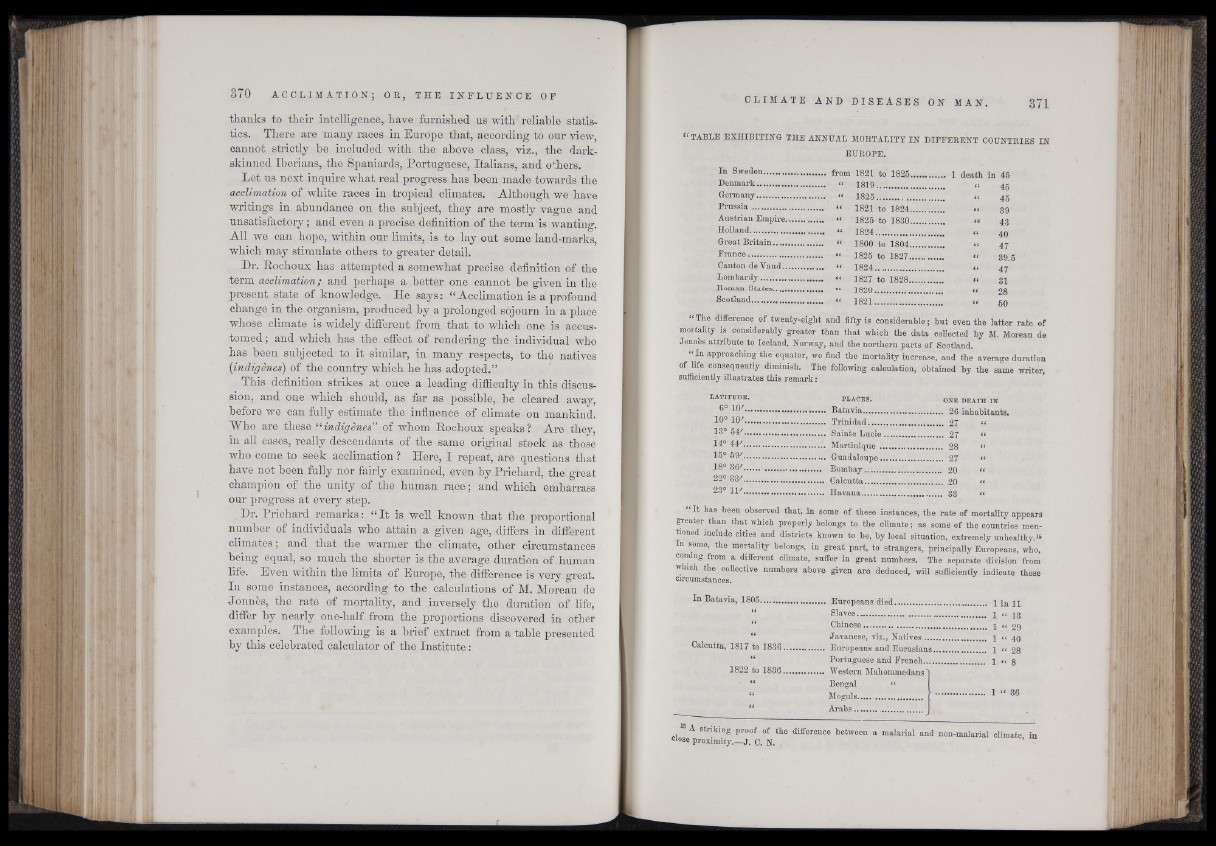
thanks to their intelligence, have furnished us with* reliable statistics.
There are many races in Europe that, according to our view,
cannot strictly he included with the above class, viz., the dark-
skinned Iberians, the Spaniards, Portuguese, Italians, and others.
Let us next inquire what real progress has been made towards the
acclimation of white races in tropical climates. Although we have
writings in abundance on the subject, they are mostly vague and
unsatisfactory; and even a precise definition of the term'is wanting.
All we can hope, within our limits, is to lay out some land-marks,
which may stimulate others to greater detail.
Dr. Roehoux has attempted a somewhat precise definition of the
term acclimation; and perhaps a better one cannot be given in the
present state of knowledge. He says: “Acclimation is a profound
change in the organism, produced by a prolonged sojourn in a place
whose climate is widely different from that to which one is accustomed
; and which has the effect of rendering the individual who
has been subjected to it similar, in many respects, to the natives
(iindigènes) of the country which he has adopted.”
This definition strikes at once a leading difficulty in this discussion,
and one which should, as far as possible, be cleared away,
before we can fully estimate the influence of climate on mankind.
Who are these .“ indigènes” of whom Roehoux speaks? Are they,
in all cases, really descendants of the same original stock as those
who come to seek acclimation ? Here, I repeat, are questions that
have not been fully nor fairly examined, even-by Prichard, the great
champion of the unity of the human race; and which embarrass
our progress at every step.
Dr. Prichard remarks: “ It is well known that the proportional
number of individuals who attain a given age, differs in different
climates ; and that the warmer the climate, other circumstances
being equal, so much the shorter is the average duration of human
life. Even within the limits of Europe, the difference is very great.
In some instances, according' to the calculations of M. Moreau de
Jonnès, the rate of mortality, and inversely the duration of life,
differ by nearly one-half from the proportions discovered in other
examples. The following is a brief extract from a table presented
by this celebrated calculator of the Institute :
EUROPE.
In Sweden........................... from 1821 to' 1825................ 1 death in 45
Denmark.
Germany..............
Prussia............... .
Austrian Empire.
Holland.................
Great Britain......
France..................
Canton de Vaud..,
Lombardy.............
Roman States.......
Scotland .
1819.. ........ .
1825.................
1821 to 1824..
1825 to 1830..
1824.... :..........
1800 to 1804..
1825 to 1827..
1824.................
1827 to 1828..
1820.................
1821.................
45
45
89
43
40
47
89.5
47
31
28
50
“ The difference pf twenty-eight and fifty is considerable; but even the latter rate of
mortality is considerably greater than that which the data collected by M. Moreau de
Jonnbs attribute to Iceland, Norway, and the northern parts of Sootland.
“ In approaching the equator, we find the mortality increase, and the average duration
of life consequently diminish. The following calculation, obtained by the same writer,
sufficiently Illustrates this remark:
LATITUDE. PLACES.
6° .................................... Batavia....................................
10° 107......................... .......... Trinidad........................ .........
13° 54'.................................... Sainte Lucie...........................
14° 447.................................... Martinique ............................
15° 59/ ................................... . Guadaloupe............................
18° 367..,.,...,,,,y.,................. Bombay..................................
22° 337................................... Calcutta...................................
23° l l 7..
ONE DEATH IN
26 inhabitants.
27 “
27 “
28 “
27 “
20 “
20 “
Havana.................................... 33
“ It has -been observed that, in some of these instances, the rate of mortality appears
greater than that which properly belongs to the climate; as some of the countries mentioned
include cities and districts known to be, by local situation, extremely unhealthy.16
In some, the mortality belongs, in great part, to strangers,, principally Europeans, who,
coming from a different climate, suffer in great numbers. The separate division from
which the collective numbers above given are deduced, wifi sufficiently indicate these
circumstances.
In Batavia, 1805............................. Europeans died .......
** Slaves *.......................
“ Chinese.................................
Javanese, viz., Natives ...
Calcutta, 1817 to 1836.............. Europeans and Eurasians
Portuguese and French...,
1822 to 1836.................. Western Mahommedans
N M Bengal “
u Moguls .................
** Arabs.................
in 11
“ 13
“ 29
“ 40
I 28
36
15 A striking proof of the difference between a malarial and non-malarial climate in
Close proximity.—J. C. N.